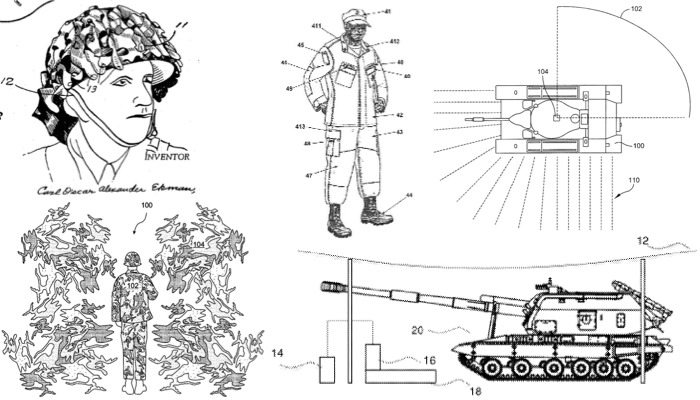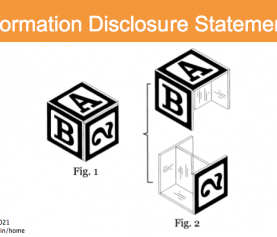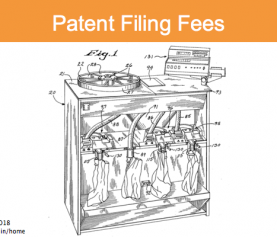Camouflage Patents
Reflecting on Veterans Day last week, as a patent attorney, I thought about inventions and patents that have kept, and still keep, our service members safer and let them do their jobs more efficiently. Camouflage is a crucial technology, helping our military personnel to do their jobs and get home safely.
Before I delve into these patents, a word on the service that our roughly 21.8 million U.S. Armed Services veterans (for details and a great dataset to explore, take a look at this, from the U.S. Dept. of Veterans Affairs), 1.4 million active-duty service members, and 850,000 reserve personnel have given to our country, and the sacrifices they’ve made. I am deeply appreciative of all that our vets and volunteers do and have done to keep our country safe, protect our national interests, and make the world a safer and more stable place. The courage and the importance of the service of all of our veterans and current service members cannot be overestimated. With that in mind, I’m glad to announce that I’m offering legal assistance pro bono, through Veterans Legal Services, to veterans. I hope to be able to serve some of those who have served us.
Now, on to some patents for camouflage that have served our servicemen and servicewomen.
Camouflage covering for helmets 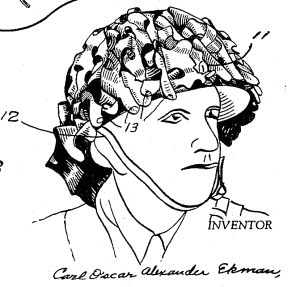
The use of camouflage by the military is not new – it dates back to the 1800s (at least), with use becoming extensive during World War I, when militaries began to employ artists to design and create camouflage. US Patent 2911652, dating to 1956, is not that old – but it demonstrates that people have been innovating in camouflage for a long time. The patent discloses using a light-absorbing and dull-surfaced sheet of plastic to cover a helmet, and arrranging it in irregular folds over the helmet, to disrupt the silhouette of the helmet.
U.S. Marine Corp uniform camouflage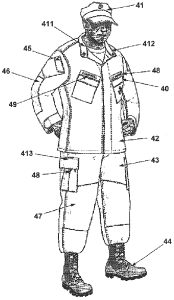
US Patent 6805957 provides a uniform that is camouflaged in both the human visible light spectrum and the near infrared range, to defeat night-vision systems (that allow people to “see” in the near-infrared spectrum). The invention uses a large-scale pattern to break up the person’s shape, and a small-scale pattern with sharper-edged areas of color, to blend the subject into the background. The invention involves printing the fabric with at least four colors, and improved performance under wet conditions, such that the uniform does not become much darker (than when dry), which reduces the effectiveness of the camouflage.
Near-ultraviolet spectrum camouflage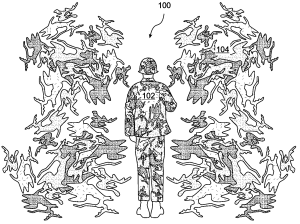
Detection systems can include UV light detection. US patent application 20110180768 disclosed a UV camouflaging substance for application to objects or fabrics. Some embodiments of the invention could include UV-absorbent and UV-reflective micro- or nano-particles, to transmit, reflect, absorb and/or scatter ultraviolet rays.
Carbon-nanotube camouflage systems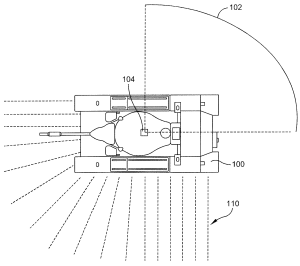
US Patent 8495946 discloses active and passive camouflage systems. With a carbon-nanotube material to absorb visible light, infrared light, and/or radio-frequency emissions, the invention adds a passive camouflage system of a plurality of optical fibers configured to receive and transmit electromagnetic energy from one portion of the surface of the camouflaged object to another, with the goal of making the object effectively transparent to light across a range of the spectrum. Alternatively, the invention adds an active camouflage system of an optical array in the carbon-nanotube material, and light-emitting devices to re-create the scene on one side of the camouflaged object for anyone viewing from the other side. Yes – this can make a tank near to invisible, or near to transparent.
Camouflaged solar power net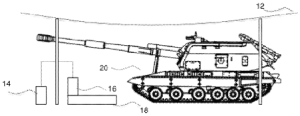
US Patent 8921685 describes a solar power array that uses active camouflage to disguise the fact that it is a solar power array, and to assist in hiding objects behind the net. Solar power is being used by the military on deployments, but typical large solar panels are easily spotted. By providing many small solar panels attached to a net, with each solar panel colored independently and able to change its color using a light emitting display, the solar panel net can conceal itself, and objects under or behind it, while also providing electrical power.
Radar-wave camouflage
Radio-frequency wavelengths in the electromagnetic spectrum are used for detection of vehicles and aircraft. US patent application 20090021415 claimed a structure, to be applied to the surface of an object, that would attenuate or cancel radio frequency electromagnetic emissions, making the object much less detectable. The structure was a base substrate, a polymer matrix with iron oxide carbide compounds and iron oxide nickel compounds, and a second polymer matrix with carbon black.


